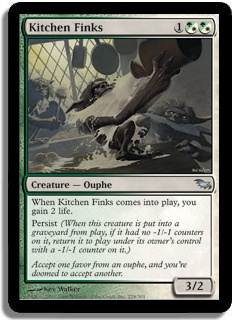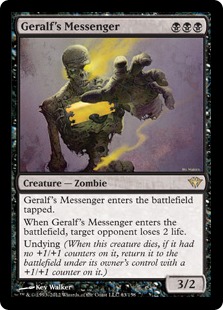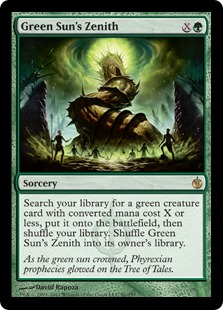In some sense, the story of Pro Tour Return to Ravnica was Stanislav Cifka incredible 18-1 run and victory with Second Sunrise Combo. But in another sense, the story of Seattle was Jund. Jund was absolutely everywhere. Pro Tour Return to Ravnica marked the first time since the Standard portion of the World Championships in 2010 that a single deck made up over 30% of the field at a Pro Tour level event. This is particularly notable because this Pro Tour was Modern, which is the largest card pool available at the Pro Tour level. Not even PT Nagoya, where Tempered Steel was predicted to run absolutely rampant in Scars of Mirrodin Block Constructed, crossed that threshold.
There are many arguments for why Jund was so heavily represented at the Pro Tour. It won the last major Modern event with Yuuya’s victory at the Player’s Championship, and it’s a relatively straightforward deck to build and play. Some people like to point to the fact that it isn’t easily “hated out” even if people are actively trying to beat you.
Jund, and the popularity of Jund, highlights what I feel is a problem with the Modern format, which essentially boils down to the fact that there are too many cards that are too good at what they do. That’s all Jund is, really: a collection of the most efficient rates of resource exchange across the appropriate colors. If you were to describe Jund’s strategy, what would it be? Is it aggro? Is it control? What are you even trying to do in a given game?
I think the most glaring example of this issue is the debate over whether you should play Kitchen Finks or Geralf’s Messenger in Jund. Finks and Messenger are literally designed as opposites of one another—both are 3/2 creatures with return to play mechanics, one that provides you with life and the other which costs your opponent life. One would think that it would be clear which of these two cards a deck would want to play based upon its strategy. If you want to be aggressive, you clearly want Messenger. If you’re defensive, you want Finks. It should be obvious, right?
Wrong. Up until the day before the Pro Tour, my testing team, comprised of many of the best players in the world, wasn’t sure whether we wanted to play Finks or Messenger in Jund. Even after playing a ten-game set of the mirror match with one deck using each expressly to determine which one to play, the results were split 5-5, with the general evaluation of which was better being “it doesn’t really matter.”
That’s the problem with Jund. Too frequently what cards actually do doesn’t matter. They’re just an interchangeable resource. Kitchen Finks and Geralf’s Messenger are both essentially the same thing, which is a three-cost creature that trades for more than a card. Dark Confidant sits in play and generates cards. Bloodbraid Elf comes down and generates a card and mana advantage. Raging Ravine is a land that’s worth more than a card because it can turn around and become a win condition.
And the opponent’s cards? They’re interchangeable, too. Thoughtseize and Inquisition don’t care about card text—whatever it is, it’s going to the graveyard. Liliana is indiscriminant about the creatures she kills or the cards she forces the opponent to discard. Abrupt Decay? Maelstrom Pulse? Whatever it is, it’s dead. Tarmogoyf and Lightning Bolt get a pass because they’re just absurdly efficient at what they do, but virtually every other card in the deck is just about picking apart whatever your opponent tries to do, no matter what it is, or exchanging resources at a favorable rate.
People talk about Jund being “hard to hate out,” and that’s really the reason. You can’t really attack Jund’s strategy both because it barely has one and because it has cards like Inquisition and Thoughtseize to handle whatever individual cards you might try to bring in to beat it.
Look at the Pro Tour-winning deck. Stanislav Cifka Second Sunrise deck isn’t designed to combat Jund—it’s designed to ignore Jund. The ability to start your combo with your card-drawing artifacts in play allows you to go off without one of your crucial combo pieces in hand, which dramatically reduces the impact of Jund’s discard. You don’t care about the efficiency of Jund’s resource exchanges because you’re not looking to exchange resources at all—in fact, you’re not looking to interact period. You just want to assemble your critical mass of cantrip and mana artifacts and then play solitaire for ten to fifteen minutes until your opponent is dead.
And your sideboard plan? Leyline of Sanctity, to ignore Jund even better. The final game of the Pro Tour was perhaps the best example of this, where Cifka literally kept a zero-land hand with a white Leyline. He pretty much just sat there accumulating resources while Yuuya attacked him anemically until he was able to go off. The two were basically just ships passing in the night, not interacting at all until one of them killed the other. Modern right now feels like a place where card text matters either too little or too much. As the reigning “fair” deck, Jund can combat virtually every other deck interchangeably with discard and just exchanges resources with them at profitable rates, while the “unfair” decks just ignore every card their opponents play unless it’s a hate card that beats them.
(As an aside, I hear a lot of people throw around the terms “fair” and “unfair” when referring to decks in Magic without much indication of what they actually mean. When I (and many others) refer to “fair” decks, we typically mean decks that operate on the normal axis of interaction for decks in Magic—they win over the course of some number of turns, typically by playing and attacking with creatures. Decks like Jund, U/W Control, and Burn are all generally considered “fair” decks. “Unfair” decks typically refer to strategies that don’t operate on this normal axis of interaction and generally includes combo decks such as Second Sunrise, Storm, Show and Tell, and Dredge.
Whether something is a “fair” or “unfair” deck under this categorization has nothing to do with how good it is but rather how difficult it is for opponents to interact with it. There’s some disagreement over whether Affinity falls into the category of “fair” or “unfair” simply because combatting it generally requires some amount of specialized hate cards like Ancient Grudge or Stony Silence. Personally, I lump Affinity into the “fair” decks since it relies on attacking to win, but I’m sympathetic to the alternate view.)
Even the deck that I designed and played in the tournament myself was basically just the shell of Jund. In attempting to build various creature decks early on, I quickly realized that trying to fight against the sheer resource exchange efficiency of Jund with normal creatures was foolish. The best answer I found—while still trying to play an interactive deck myself—was Lingering Souls. Lingering Souls is resistant to both Thoughtseize and Inquisition thanks to flashback and fights against both of Liliana’s non-ultimate abilities very well.
Here’s the list I played:
Creatures (19)
- 4 Dark Confidant
- 1 Aven Mindcensor
- 4 Tarmogoyf
- 2 Kitchen Finks
- 4 Knight of the Reliquary
- 4 Deathrite Shaman
Lands (24)
Spells (17)

The deck was basically Jund with white instead of red—Lingering Souls instead of Bloodbraid Elf, Path to Exile instead of Lightning Bolt, and Knight of the Reliquary instead of Liliana. I liked the deck, and in testing I felt like it had many of the same good matchups as Jund (thanks to being so similar to Jund) while maintaining a marginal edge in the pseudo “mirror” thanks to the power of Lingering Souls, which also happens to be extremely powerful against Affinity. Â
Unfortunately, my testing results did not carry through into the tournament, and I went 2-3 in Constructed, with two of my three losses coming against Jund decks. I could bemoan the fact that I only drew Lingering Souls three times in the entire tournament (nearly four, but one was revealed to a Dark Confidant flip that killed me), but it is what it is.
The sad thing to me is that in retrospect, I think my deck may have been improved by shifting it even more in the direction of resembling Jund. The least effective card in the deck was probably Knight of the Reliquary. That’s a tough thing for me to say because Knight is my favorite card in the history of Magic and is clearly an incredibly powerful card. The problem with Knight is that it’s a three-cost creature that dies to removal—put another way, it’s a card that does not generate favorable resource exchanges.
Knight actually has to sit in play and survive to generate any kind of advantage, which is asking a lot of a creature that costs more than one mana these days. Even with an array of powerful utility lands in my deck that were synergistic with my other cards, I likely would have been better off maxing out on Kitchen Finks and including Lilianas of my own for raw resource exchange, but at that point it’s not even clear that I shouldn’t just be Jund.
Modern looks like a diverse format because people show up with decks that look different, but many of them ultimately feel the same. It’s still funny to me that cards like Wild Nacatl and Green Sun’s Zenith are banned. The goal of banning Wild Nacatl was to increase the diversity of aggressive decks in the format. Where is that diversity?
To quote Erik Lauer’s explanation of the banning of Wild Nacatl: “The problem is that other decks try to use synergy to get rewards, but those rewards aren’t any better than the Wild Nacatl. For example, the Doran decks use Treefolk Harbinger to find Doran. When it all works, the Harbinger is effectively a 3/3 for one green. With shocklands, Wild Nacatl is a 3/3 and doesn’t let you down when your opponent kills your Doran. With some effort, Student of Warfare becomes a 3/3 first strike creature, but that isn’t a sufficient reward for the effort compared with Wild Nacatl. This creature is so efficient that it’s keeping too many other creature decks from being competitive. So, in the interest of diversity, the DCI is banning Wild Nacatl.”
Despite the banning of Wild Nacatl, we’re not seeing Treefolk Harbinger or Student of Warfare making waves. This is not only because they’re overshadowed by Nacatl’s successors, Steppe Lynx and Delver of Secrets, but because they’re fighting against cards that are just far too efficient at dealing with them or the cards they’re reliant upon for their synergies.
Green Sun’s Zenith is a card that people seem incredibly scared of, and I’m not entirely sure why. Yes, the ability to fetch Dryad Arbor is quite powerful. The ability to Tutor for any green creature in your deck is also good, as the success of Maverick in Legacy shows us. But that Tutor ability means that we actually see cards played for their card text rather than simply for their rate, which is a direction I think Modern could stand to move toward.
I feel like Green Sun’s Zenith got knee-jerk banned as a result of its popularity in Primeval Titan / Cloudpost decks leading up to PT Philly (where such decks did not even perform particularly well). I think the kind of format where a person is willing to pay an extra mana for a particular green creature sounds like a fine place to be—certainly more interesting than the current one.
I’ll be playing in the upcoming Modern GP in Chicago, but I’m not excited about it. As it stands right now, all I want to do is play a deck designed to go toe-to-toe with Jund in resource exchange with a sideboard packed full of hate cards for the unfair decks. Maybe some kind of little kid G/W deck—who knows. I haven’t started testing because I’m sick to death of the format.  Â
I’m not sure what the best way to shake up Modern is, but I think unbanning Green Sun’s Zenith is a good start. Don’t worry—I’m not selfish. I could see Ancestral Visions, Jace, or Bitterblossom finding their way off the banned list as well. All I know is that something needs to happen because another tournament full of Jund and combo decks does not sound like my idea of a good time.
In the meantime, GP Philadelphia is this weekend, and I have to say I’m happy to play some Return to Ravnica Limited! It’s a sweet format, and hopefully I can pick up some points to help offset my poor finish in Seattle. If you’re there and see me, be sure to say hello—I always enjoy meeting my fans and readers.
Until next time,
bmk




